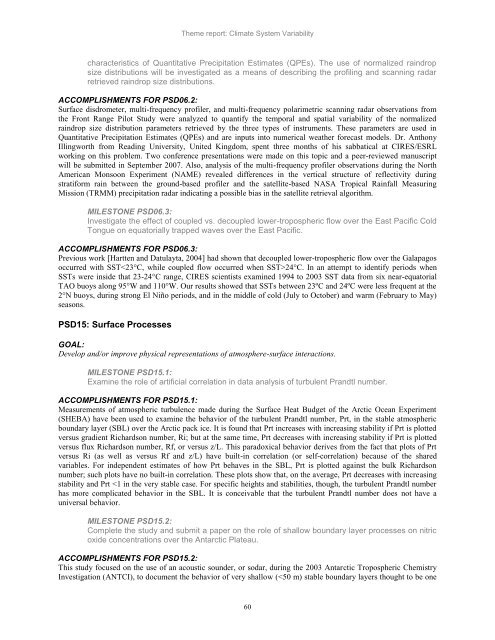Scientific Theme: Advanced Modeling and Observing Systems
Scientific Theme: Advanced Modeling and Observing Systems
Scientific Theme: Advanced Modeling and Observing Systems
You also want an ePaper? Increase the reach of your titles
YUMPU automatically turns print PDFs into web optimized ePapers that Google loves.
<strong>Theme</strong> report: Climate System Variability<br />
characteristics of Quantitative Precipitation Estimates (QPEs). The use of normalized raindrop<br />
size distributions will be investigated as a means of describing the profiling <strong>and</strong> scanning radar<br />
retrieved raindrop size distributions.<br />
ACCOMPLISHMENTS FOR PSD06.2:<br />
Surface disdrometer, multi-frequency profiler, <strong>and</strong> multi-frequency polarimetric scanning radar observations from<br />
the Front Range Pilot Study were analyzed to quantify the temporal <strong>and</strong> spatial variability of the normalized<br />
raindrop size distribution parameters retrieved by the three types of instruments. These parameters are used in<br />
Quantitative Precipitation Estimates (QPEs) <strong>and</strong> are inputs into numerical weather forecast models. Dr. Anthony<br />
Illingworth from Reading University, United Kingdom, spent three months of his sabbatical at CIRES/ESRL<br />
working on this problem. Two conference presentations were made on this topic <strong>and</strong> a peer-reviewed manuscript<br />
will be submitted in September 2007. Also, analysis of the multi-frequency profiler observations during the North<br />
American Monsoon Experiment (NAME) revealed differences in the vertical structure of reflectivity during<br />
stratiform rain between the ground-based profiler <strong>and</strong> the satellite-based NASA Tropical Rainfall Measuring<br />
Mission (TRMM) precipitation radar indicating a possible bias in the satellite retrieval algorithm.<br />
MILESTONE PSD06.3:<br />
Investigate the effect of coupled vs. decoupled lower-tropospheric flow over the East Pacific Cold<br />
Tongue on equatorially trapped waves over the East Pacific.<br />
ACCOMPLISHMENTS FOR PSD06.3:<br />
Previous work [Hartten <strong>and</strong> Datulayta, 2004] had shown that decoupled lower-tropospheric flow over the Galapagos<br />
occurred with SST24°C. In an attempt to identify periods when<br />
SSTs were inside that 23-24°C range, CIRES scientists examined 1994 to 2003 SST data from six near-equatorial<br />
TAO buoys along 95°W <strong>and</strong> 110°W. Our results showed that SSTs between 23ºC <strong>and</strong> 24ºC were less frequent at the<br />
2°N buoys, during strong El Niño periods, <strong>and</strong> in the middle of cold (July to October) <strong>and</strong> warm (February to May)<br />
seasons.<br />
PSD15: Surface Processes<br />
GOAL:<br />
Develop <strong>and</strong>/or improve physical representations of atmosphere-surface interactions.<br />
MILESTONE PSD15.1:<br />
Examine the role of artificial correlation in data analysis of turbulent Pr<strong>and</strong>tl number.<br />
ACCOMPLISHMENTS FOR PSD15.1:<br />
Measurements of atmospheric turbulence made during the Surface Heat Budget of the Arctic Ocean Experiment<br />
(SHEBA) have been used to examine the behavior of the turbulent Pr<strong>and</strong>tl number, Prt, in the stable atmospheric<br />
boundary layer (SBL) over the Arctic pack ice. It is found that Prt increases with increasing stability if Prt is plotted<br />
versus gradient Richardson number, Ri; but at the same time, Prt decreases with increasing stability if Prt is plotted<br />
versus flux Richardson number, Rf, or versus z/L. This paradoxical behavior derives from the fact that plots of Prt<br />
versus Ri (as well as versus Rf <strong>and</strong> z/L) have built-in correlation (or self-correlation) because of the shared<br />
variables. For independent estimates of how Prt behaves in the SBL, Prt is plotted against the bulk Richardson<br />
number; such plots have no built-in correlation. These plots show that, on the average, Prt decreases with increasing<br />
stability <strong>and</strong> Prt
















